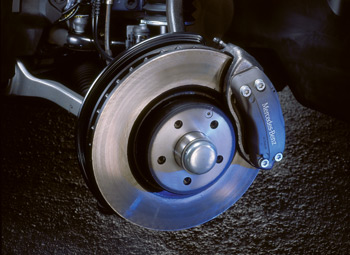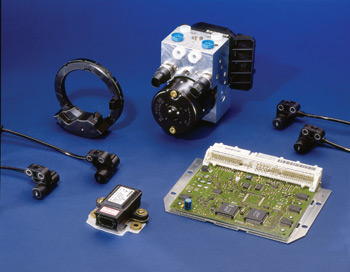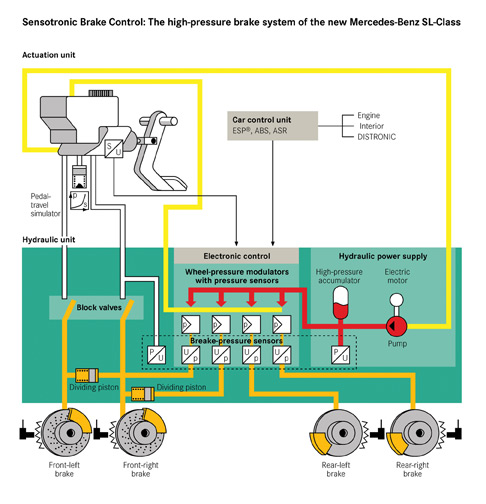Over the past decade, other vehicle manufacturers including Audi, BMW, Volkswagen, Lexus, Toyota and Mitsubishi have added Brake Assist to many of their vehicles. Lexus added Brake Assist in 2000, and made it standard on all models except the IS 300 in 2001. You’ll even find it on 2009 Toyota Corollas. 
What’s so great about Brake Assist? It helps vehicles stop faster and in less distance, hopefully reducing the risk of hitting obstacles, pedestrians or other vehicles. Many drivers are slow to react to emergency situations that call for immediate braking, and when they do react they often don’t press down hard enough on the brake pedal. Worse yet, if the ABS system kicks in, the noise and vibrations that feed back through the brake pedal may startle them, causing them to lift their foot off the pedal momentarily, or to pump the brakes. Either of these actions will reduce the effectiveness of the ABS system, and may increase the distance it takes to come to a complete stop.
A conventional vacuum power brake booster multiplies the force the driver exerts on the brake pedal by using atmospheric pressure working against a diaphragm to push the master cylinder pushrod. It’s a relatively simple setup and usually causes few problems. But a conventional power booster responds only to how hard the driver presses down on the brake pedal. It has no way of knowing if the brakes are being applied for a normal or panic stop.
Since the stopping distance of any vehicle depends on the reaction time of the driver, and how hard the brakes are applied, the only way to reduce the stopping distance is to allow the brakes to react more quickly and to apply with full force in an emergency situation. Brake Assist uses several techniques to accomplish this task.
BRAKE PRESSURE LOAD SWITCH
A switch that is usually located at the top of the brake pedal assembly monitors the speed and pressure with which the driver normally applies the brakes. The signal sent from the switch is monitored by the brake control module to develop a typical braking profile for the driver. Additional inputs from the ABS wheel speed sensors, vehicle speed sensor and/or yaw and acceleration sensors may also be used to determine if the vehicle is braking normally, or if it is being braked hard in a panic-stop situation.
On some applications with throttle-by-wire, the control module also monitors the position of the accelerator pedal position to determine when the driver lifts his or her foot from the gas pedal to apply the brakes.
If the control module determines the brakes are being applied in an emergency situation, Brake Assist takes over and uses stored pressure from the ABS accumulator to apply maximum pressure to all four brakes. If the vehicle is also equipped with Skid Control or Stability Control, those systems will kick in as well to make sure the vehicle stops straight and in the least distance possible.
On many applications, the Brake Assist system preloads the brakes to minimize the distance the disc brake pads have to travel to contact the rotors the moment the driver lifts his foot off the accelerator pedal. This minimizes the reaction time of the brake system so the car can stop in a shorter distance when the driver applies the brakes.
BRAKE ASSIST FAULTS
A fault in the Brake Pressure Load Switch, ABS pump, accumulator, hydraulic modulator, wheel speed sensors or control module should set a fault code and turn on the ABS warning light. Any problems in the hydraulics, such as a fluid leak that allows a loss of pressure, should turn on the Brake warning light.
Diagnostics will vary depending on the vehicle and application, but, at the very least, you will need a scan tool that can access and display ABS codes. A factory scan tool, or an aftermarket scan tool with the appropriate software, may also be required to run any system self-tests.
If Brake Assist is not working, at worst the vehicle should have normal power braking (assuming the hydraulic brakes and vacuum booster are functioning normally). The driver may not even realize something is wrong unless there’s a warning light on the dash. That’s because Brake Assist comes into play only in emergency-stop situations.
Common problems that can prevent a Brake Assist system from working properly include anything that prevents the ABS system from developing normal pressure in the accumulator. That includes a bad ABS pump relay, failed pump motor or a leak in the high-pressure accumulator. A failure of the brake control module or brake pressure load switch would also prevent Brake Assist from intervening in an emergency.
BRAKE ASSIST PLUS
In 2006, Mercedes upped the capabilities of its Brake Assist system by adding a collision-warning feature using radar to detect other vehicles or obstacles in the road ahead. By monitoring the closing distance between the vehicle and other cars or objects in the road ahead, the system can warn the driver if braking is needed. The brake system is also pre-charged to decrease the reaction time when the brakes are applied. Mercedes calls this Brake Assist Plus, and uses it on its S-Class cars.
The radar-ranging feature comes from the car’s adaptive cruise control system that maintains a safe distance between vehicles rather than a preset speed while driving. The “Distronic” cruise control system uses a radar transponder and receiver mounted behind the grill to scan the road ahead. The data is then shared with the Brake Assist Plus system to keep the driver informed of any possible hazards, and to pre-charge the brakes if it appears that braking will be needed.
MERCEDES PRE-SAFE BRAKING
Taking this technology a step further, Mercedes added a new feature in its 2007 and up S-Class and CLS-Class models. It’s also found on its 2009 E-Class models. It’s called “Pre-Safe” braking. With this system, the brakes are lightly preloaded if the system senses braking will be needed because the vehicle is approaching a stationary object in the road ahead, or the vehicle ahead is braking. The system will flash a warning to alert the driver. If the driver fails to react in time, Pre-Safe braking takes over and applies partial braking (about 40% of maximum brake force) to slow the vehicle.
The Pre-Safe system uses two near range radar sensors behind the front bumper to detect vehicles ahead, with a maximum range of 30 meters, at an angle of up to 80 degrees. An additional long-range radar sensor is located in the grille to detect vehicles up to 150 meters ahead (200 meters on 2009 models). The system is active from 30 to 112 mph on the 2007 and 2008 applications, and up to 124 mph on the 2009 and 2010 models, but intervenes only with automatic braking if the car is approaching a stationary vehicle from behind at speeds under 43 mph.
MERCEDES SENSOTRONIC BRAKES
Another variant of Brake Assist that Mercedes uses on some of its vehicles is its Sensotronic Brake Control (SBC) system. This electronic braking system has no vacuum booster. It uses pressure from the ABS pump and accumulator for normal braking as well as Braking Assist and ABS braking. It does have a conventional master cylinder for fail-safe backup. The master cylinder also has a pedal pressure sensor (actually two Hall Effect sensors in one unit), and a pedal simulator to simulate the feel of a conventional brake system. 
Sensotronic was introduced in Europe in 2001, and on U.S. SL-Class and E-Class cars in 2003. Sensotronic is still used on SL-Class models, but was discontinued on the E-Class models in 2006 due to recall problems (wiring harness problems and control module glitches). If a fault causes the system to shut down, the brakes revert to conventional manual brakes with no power assist.
The Sensotronic brake system combines Brake Assist, brake system precharging, antilock braking and stability control into one integrated system. It does not, however, provide any collision warnings or automatic braking as with Pre-Safe braking.
The system is activated as soon as the doors on the vehicle are unlocked, or when the driver turns on the ignition or steps on the brake pedal. It immediately performs a pre-drive self-check by checking all the system sensors, operating the ABS pump and applying pressure to the calipers. It repeats this self-check every 16 brake applications while the car is being driven. 
The Sensotronic system remains active for up to two minutes after the ignition has been turned off and the vehicle has remained stationary without touching the brake pedal. Touch the brake pedal, and the system will remain active another four minutes. If you use the keyless entry system to lock the doors, the Sensotronic system times out after 30 seconds. This is important to know, because if you are working on the brakes and the system is activated, the brakes will apply themselves if anybody moves the brake pedal.
To deactivate the system, remove the keyless entry fob from the vehicle, and then lock the doors. Move the key out of range from the vehicle so the system cannot be accidentally activated. After 30 seconds, the Sensotronic system should time out and go into sleep mode. Do not unlock the vehicle while any brake work is being performed and do not touch the brake pedal. Once the work has been completed, the system needs to be reactivated using the following procedure:
1. Turn on the ignition.
2. Turn off the ignition, wait five seconds and then turn it back on.
3. With wheels off the ground, rotate the left rear wheel in the forward direction two revolutions within three seconds, and then stop.
4. Rotate the left front wheel two revolutions in the forward direction within 60 seconds after completing step 3.
The Sensotronic system will then automatically apply the brakes, and flash the brake lights three times to signal it has been reactivated. It will then do a quick self-check and apply the front and rear brakes several times in quick succession. After 50 seconds, the braking will stop.
5. Turn off the ignition, then lower the vehicle to the ground.
6. Start the engine and press the brake pedal five to 10 times. If any faults are found, you will get a fault message on the driver’s display. Repeating the activation procedure may be necessary to clear the fault. But if the fault message remains, you’ll have to hook up a scan tool to read the codes to find out what’s wrong.
There are a couple of ways to bleed the brakes on this system, both of which require a pressure bleeder. With the scan tool method (which requires the factory STAR scan tool or an aftermarket scan tool with similar software), just follow the menu prompts to bleed the system.
The other method is to use the pressure bleeder to bleed the front brakes (left front, then right front) after deactivating the Sensotronic system. To bleed the rear lines, the system is reactivated using the procedure described earlier. Pressure generated by the ABS pump can then be used to bleed the right rear brake circuit. The pump will kick in about 40 seconds after the brake lights stop flashing. You then have about 40 seconds to open the bleeder screw, and 150 seconds to finish bleeding the line.
If you wait too long to open the bleeder screw, the bleed routine will stop and you’ll have to start over by deactivating, then reactivating, the Sensotronic system again. After you finish with the right rear brake, repeat the same procedure to bleed the left rear brake circuit.
Note: Air in the system can cause a squeaking noise when the brakes are lightly applied, so the factory STAR scan tool has a special “air release” routine that takes about 10 to 15 minutes to complete.













